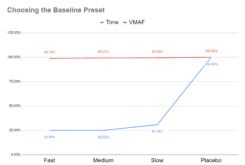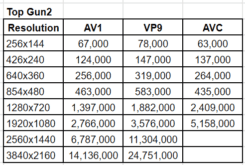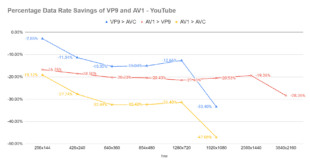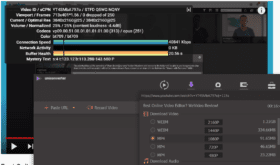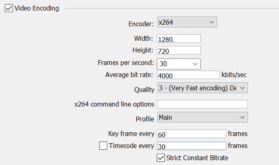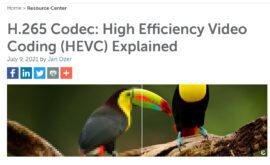OK, I’ll say it. As far as I know, this is the first time any study has compared the quality and performance of codecs representing Essential Video Coding (EVC), Versatile Video Coding (VVC), and Low Complexity Enhancement Video Coding (LCEVC), as well as AV1, HEVC, and H.264. It’s not as exhaustive as I would like but the results should help …
Read More »It’s The Year of AV1. 2023, That Is.
A recent Netflix post trumpets AV1’s suitability for mass-market distribution, but high encoding costs, the lack of HDR support, and nascent support in the living room make AV1 a non-starter for most producers. Most of these issues should be resolved by mid-2023, when mainstream usage should really start to blossom. Netflix: AV1 on (Some) Smart TVs In their November 2021 …
Read More »Talking Codecs on the Video Insiders Podcast
I’m a big fan of the Video Insiders podcast and have learned a lot from many of the episodes. I’m proud to have joined Dror Gill and Mark Donnigan for episode 70, which you can listen to or download here. Here’s the description: EPISODE SUMMARY The Video Insiders podcast is celebrating 70(!) episodes with a very special guest – Jan …
Read More »Basic YouTube-DL Commands to Download Files from YouTube
This article describes what youtube-dl is, and outlines several basic youtube-dl commands for audio/video/subtitle downloads. I’ve always been fascinated with how YouTube encodes the endless hours of videos uploaded to the site. YouTube employs the best and the brightest and their task is positively Sisyphean. For years, I’ve gotten a glimpse of YouTube’s encoding practices via download tools like the …
Read More »Which Codec Does YouTube Use, Part III
This article analyzes the codecs used by YouTube for 4K videos with millions of views, and the savings that AV1 and VP9 deliver over YouTube’s full encoding ladder. This is the third in a series of articles written about which codecs YouTube uses. The first covers which codecs YouTube uses for high-volume 1080p videos. The second covers the codecs used …
Read More »Which Codec Does YouTube Use, Part Deux
YouTube encodes some videos using the AV1 and VP9 codecs. This post identifies the H.264 versions also created by YouTube for devices incompatible with VP9/AV1 for 1080p and larger videos. In a recent post, I explored which codecs YouTube used for videos ranging from a few hundred views to a few million. The conclusion was H.264 for videos with a …
Read More »Which Codecs Does YouTube Use?
Author’s Note (March 15, 2022): A colleague recently advised me that YouTube was now encoding all videos into VP9 format. A quick check revealed that he was correct; literally every video that I checked, including some uploaded back in 2010, was encoded into VP9 as well as H.264. What’s interesting is that many low-volume videos, like this one with 118 …
Read More »Beginner’s Guide to Encoding H.264
The H.264 codec is still the most widely used video compression technology — aka codec in the world and likely will be for the next few years. For this reason, every streaming media professional should know what the H.264 codec is and how to encode with H.264. This beginner’s guide to encoding H.264 will describe what H.264 is, detail the …
Read More »AV1 Codec: AOMedia Video 1 Explained
This article on the Wowza website provides a quick overview of the AV1 codec: what it is, how it performs, what it costs, and what it’s good for today. It’s useful if you want to get a quick feel for where AV1 fits in with other codecs. The article is the fourth in a five-part series that covers H.264, VP9, …
Read More »H.265 Codec: High Efficiency Video Coding (HEVC) Explained
This article on the Wowza website provides a quick overview of the HEVC codec: what it is, how it performs, what it costs, and what it’s good for. It concludes with a section on what you need to know to effectively deploy the HEVC codec using the Wowza Streaming Engine software. The article is the third in a five-part series …
Read More » Streaming Learning Center Where Streaming Professionals Learn to Excel
Streaming Learning Center Where Streaming Professionals Learn to Excel


